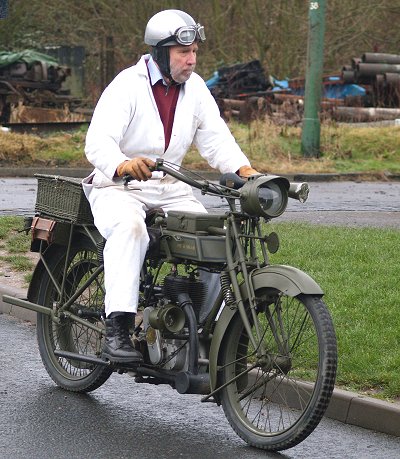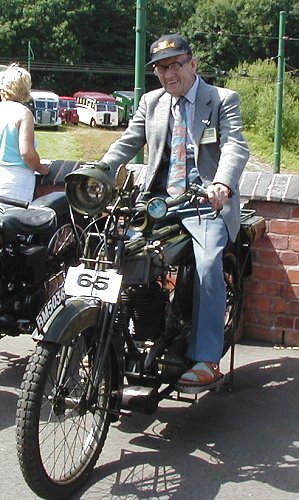| The War Years
At the outbreak of war, Sunbeam started to
develop machines for use in the armed forces. The 3½ hp. machine was
modified for service use and given an improved magneto drive, via an
inverted Morse chain. A new gearbox was fitted with constant-mesh
gears, and the fuel tank had three separate compartments, one
contained petrol, another contained oil, and the third contained
paraffin |

Ken Norton riding the Black Country
Living Museum's 3.5 hp. Sunbeam military machine. This is the
French version with belt drive. |
The machines were finished
in matt khaki with black lining and gold lettering. Sunbeam also
produced some machines for the French army, which were the only
Sunbeams produced with a belt drive.
In 1915 it was becoming
difficult to obtain JAP engines, due to sales to the War Department,
and so the 6 hp. machine was modified to accept a Sunbeam 6 hp. 73 mm.
x 95 mm. twin engine.
The modified 6 hp. machines
were also sold to the War Department, and were in service in Russia
and Italy. Sunbeam also launched two new sidecars, 'Number 1' and
'Number 2'. These were built by Charles Hayward, who later joined
A.J.S. He started in a loft at the Sunbeam works, but was soon
forced to move due to lack of space.
Nine gold medals were won by
Sunbeam in the 1915 Style Cop hill climb. This was mainly due to the
efforts of George Dance on a newly developed
4 hp. single. |
|
During 1916 large numbers of
Sunbeam motorcycles were supplied to the Russian Army for use on the
Eastern front. A new 8 hp. twin with a 3 compartment fuel tank was
developed for this purpose. It was fitted with a machine gun and
armoured sidecar. The machines were powered by a Swiss 996 c.c. MAG
engine, and had Brampton 'Biflex' forks.
The sidecar was also
produced as an ambulance (stretcher carrier) and there was even a
double decker version. A 4 hp. and later 3½ hp. version was sold to
the French army. These had a belt drive and were the only Sunbeams
to be so equipped.
On 3rd November, 1916 the Ministry of Munitions
suspended civilian production for the duration of the war, and so
Sunbeam had to rely on W.D. contracts. In response to this the
company stepped up production of vehicle and aircraft radiators
which were needed in large quantities.
By 1918, JAP engines were
available again and so the 8 hp. MAG engine was replaced with a JAP
equivalent. This gave the machine an extra 4 inch ground clearance!
The motorcycle machine gun versions were unsuccessful as an
effective weapon and so W.D. contracts for them were cancelled or
terminated. |

George Peck on Bill Barton's Sunbeam General Service from 1916. |
|
1918 was a disastrous year
for the Marston family. John Marston's 3rd son, Roland, died at the
early age of 45. He had been groomed as his father's successor at
Sunbeam, and his untimely death came as a great shock to his
parents. At the time John and his wife Ellen were staying at their
house at Colwyn Bay. Unfortunately this was too much for John, who
was overcome with grief. He died on the
8th March, the day after Roland's funeral. Sadly, Ellen also died
six weeks later. John and Ellen were buried at Colwyn Bay.
The armistice was signed on
11th November and all fighting ceased. The Government immediately
cancelled the surviving wartime contracts and ex-Sunbeam men
returning from the war found themselves on a waiting list for their
former jobs, which had been filled in their absence. |

|
|

|
|

|
| Return to The
Early Years |
|
Return to the
beginning |
|
Proceed to The
Golden Years |
|